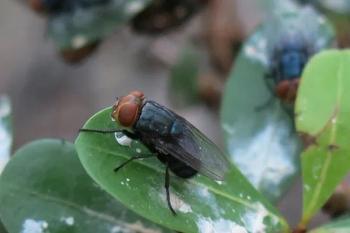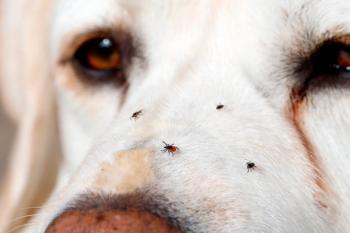
Parasitology update--new parasites, new problems (Proceedings)
In addition to the common parasitic infections encountered frequently in practice, veterinarians need to be alert for the occasional parasite new to you because it typically is limited to other parts of the US or the world.
In addition to the common parasitic infections encountered frequently in practice, veterinarians need to be alert for the occasional parasite new to you because it typically is limited to other parts of the US or the world. In some cases, a parasite may be expanding its range or increasing in prevalence because of environmental factors, in others travel is breaking down geographic boundaries to. Here a few parasites that you may not have seen, but should know are out there:
Cytauxzoonosis
Cytauxzoon felis is a protozoan parasite primarily of bobcats, which has only been recognized as a potential pathogen of cats in the past 30 years. The parasite is transmitted by ticks, primarily by Dermacentor variabilis, the American Dog Tick. Recent research has shown that C. felis can also be transmitted by the Lone Star Tick, Amblyomma americanum. A survey conducted over a large region of the US found that prevalence rates in bobcats were higher where both Dermacentor and Amblyomma occur compared to regions where Amblyomma is not found or is present in small numbers.
The Lone Star tick historically has been a southeastern tick, but its range has expanded dramatically in the last few decades and is expected to continue expanding. Our initial understanding of this infection was that infection of cats was almost invariably fatal, but reports of cats surviving infection are increasing and a recent PCR survey of asymptomatic cats in the southeastern US found a surprisingly high prevalence of infection with strains associated with clinical cases. These results may indicate that cats can also serve as a reservoir of infection.
Following infection from a tick, the parasite invades mononuclear phagocytes in blood vessel walls and multiplication occurs. Following maturation of the schizont stage, it ruptures and releases merozoite stages that invade red blood cells. Stages in the RBCs also undergo multiplication but disease results from blockage of small blood vessels with large macrophages containing schizonts. Clinical cases present with fever, lethargy, anemia, dehydration , dyspnea, icterus, anorexia and splenomegaly. The presence of parasites in the RBC usually accompanies the development of fever and the level of parasitemia is related to the likelihood of survival. Clinical chemistry reflects damage to organs as blood cells become occluded with schizonts containing macrophages.
Diagnosis is often made by detection of merozoites in RBCs, but disease may develop before the erythocyte stage is seen. Aspirates of spleen, liver or kidney may be useful in early detection. PCR tests are also available at several university and diagnostic labs, although results should be interpreted cautiously since techniques vary among labs and false negatives and positives may occur.
Treatment success has been variable and a number of compounds have been used including clindamycin, penicillin and doxycycline. The antiprotozoal drug imidocarb has also been used. In a recent prospective study from NCSU, atovaquone (15 mg/kg PO every 8 hr and azithromycin (10 mg/kg every 24 hr) for 10 days led to a higher survival rate to hospital discharge than imidocarb treatment (Cohn et al, 2011). Prevention of infection is recommended by use of tick control products and reducing access of cats to areas where tick exposure occurs.
Trypansomiasis
Another protozoan parasite most often seen in dogs in the southeastern US could be encountered in other parts of the country because of owner travel or translocation of pets for adoption. Trypanosoma cruzi is a flagellate hemoprotozoan transmitted by an insect intermediate host. It is an important zoonotic disease (Chagas disease) in parts of Latin America. It is also widely distributed in wild animals in the southeastern US and has been described as far north as Maryland. In both humans and dogs, T. cruzi can cause cardiac disease, although in North America disease in humans is uncommon.
In the standard lifecycle of T. cruzi, a flagellated bloodstream form of the parasite is ingested with a blood meal by the intermediate host, a triatomid bug. Development to the infective stage occurs in the bug and infection of a new host occurs when the bug defecates following feeding and infective stages are rubbed into the bite wound. Infection also appears to occur if an infected bug is eaten by a potential host and this may be an important route of infection in some animals. Congenital infection in dogs has also been reported in the US.
Following infection, the parasites enter macrophages and spread through the body. About 2 weeks after infection parasites are found in the blood and signs of acute infection occur (lymphadenopathy, lethargy) and may be accompanied by myocarditis. In some dogs, particularly adults, signs of acute disease may be absent. Some, but not all infected dogs develop disease over 8-36 months. In chronic disease parasites are no longer present in the bloodstream. Cardiac signs associated with right sided and sometimes left-sided failure may develop including ascites, pulse deficits, pleural effusion, hepatomegaly and jugular venous congestion. The presentation of these cases cannot be distinguished from chronic dilative cardiomyopathy that occurs in large breed dogs.
Chagas disease should be considered in any dog presenting with myocarditis or cardiomyopathy with a history of being in any area where the infection is endemic or a history of blood transfusion from a dog from an endemic area. In chronic infection detection of the bloodstream form of the parasite is very unlikely. Immunologic analysis by IFA and ELISA tests is available but most of these tests crossreact with Leishmania infection. PCR is highly specific for the parasite, but a less sensitive procedure than serology. Typically serology plus clinical signs are used to assign a diagnosis of trypanosomiasis The drug currently recommended for treatment is benznidazole (5-10 mg/kg PO daily for 2 months).
However, in the chronic and even in acute stages a clinical cure may not occur. Adding to the difficulty of case management is the zoonotic importance of the parasite. The insect intermediate host is not commonly encountered by people in the US, so transmission by that route is unlikely, but care should be taken to avoid direct contact with infected dog blood and clients must be advised that their pet's infection is zoonotic.
Leishmaniasis
Cases of Leishmania spp infection similarly represent zoonontic infection that is difficult to treat and may cause chronic disease signs. Leishmania infantum is present in southern Europe, where infection in humans and dogs is important. In the U.S. the infection is primarily associated with foxhound kennels either because of increased susceptibility in that breed or because of factors associated with management of foxhounds that facilitate transmission.
Sand flies are the natural intermediate host of the parasite, but in the US it is not believed that sand flies play a role in transmission to dogs. Instead, both horizontal transmission through blood contact and vertical transmission from dam to puppies is thought to be responsible for transmission. Clinical disease appears to be absent in many infected animas, but in susceptible animals a chronic syndrome of condition loss, depression, generalized lymphadenopathy, splenomegaly and variety of other signs. Diagnosis can be made following detection of amastigotes in tissue biopsies or aspirates of lymph node, bone marrow or spleen. However, organisms may be difficult to detect in chronic infection.
Immunologic tests may cross react with Trypansoma cruzi, although the K39 dipstick immunoassay does not cross react. PCR tests conducted with stringent controls can also be used for diagnosis. Treatment is very difficult. Sodium stibogluconate (Pentostam) has been available from the CDC, but relapses are common and the organism cannot be assumed to be cleared from the animals. Maintenance therapy with allopurinol will maintain dogs in an asymptomatic state and make them less likely to transmit infection. Owners of infected dogs must be cautioned to avoid direct contact with blood.
Heterobilharziasis
Another parasite associated with the southeastern U.S that might be expanding its range northward is Heterobilharzia americana. This trematode parasite has various wild definitive hosts like raccoons and nutria, but can also infect dogs. Like other members of the schistosome family of flukes, Heterobilharzia has a snail intermediate host but no second intermediate host.
Cercariae are produced in snails, released in water and directly penetrate the skin of the definitive host. Like some schistosomes parasitizing humans, Heterbilharzia adults are found in the mesenteric veins of the host. Unlike most flukes, schistosomes have separate sexes and female worms deposit eggs in capillaries. The release of enzymes from the eggs in conjunction with the host inflammatory response helps moves eggs through the tissue and intestinal wall leading to their entry into the intestinal lumen and passage in the feces. Disease associated with infection is the result of inflammation, granuloma formation and scarring resulting from the presence of eggs in the intestine, liver and other organs. Common signs of infection are weight loss, lethargy, diarrhea and anorexia.
Hypercalcemia was also seen in a number of dogs in a recent survey (Fabrick et al, 2010). Diagnosis of Heterobilharzia infection is difficult and it is likely that many infections are not diagnosed. Fluke eggs are usually too dense to float in typical flotation solutions and sedimentation procedures are recommended. However, in the case of Heterobilharzia, performing a routine sedimentation in water stimulates eggs to hatch and release swimming miricidia that are not recovered in the sediment.
As a result, for diagnosis of Heterobilharzia it is recommended that the sedimentation procedure be conducted using saline instead of water to prevent egg hatching. A PCR fecal antigen test is also available at the diagnostic lab of the College of Veterinary Medicine, North Carolina State University. Histopathologic examination of biopsies may also reveal the presence of the eggs. Praziquantel and fenbendazole have been used for treatment for the parasite.
References
Barr SC. 2009. Canine Chagas Diseae (American trypanosomiasis) in North America Vet Clin Small Anim. 39:1055-1064.
Brown HM, Lockhart JM, Latimer KS, Peterson DS. 2010. Identificatin and genetic characterizaton of Cytauxzoon felis in asymptomatic domestic cats and bobcats. Vet Parasitol. 172:311-316.
Cohn LA, Birkenheuer AJ, Brunker JD, Ratcliff ER, Craig AW. 2011. Efficacy of atovaquone and azithromycin or imidocarb dipropionate in cats with acute cytauxzoonosis. J Vet Intern Med. 25:55-60.
Fabrick C, Bugbee A, Fosgate G. 2010. Clinical features and outcome of Heterobilharzia americana infection in dogs. J Vet Intern Med. 24:140-144
Holman PJ, Snowden KF. 2009. Canine hepatozoonosis and babesiosis, and feline cytauxzoonosis. Vet Clin Small Anim. 39:1035-1053.
Petersen CA, Barr SC. 2009. Canine leishmaniasis in North Anerica: emerging or newly recognized? Vet Clin Small Anim. 39:1065-1074.
Newsletter
From exam room tips to practice management insights, get trusted veterinary news delivered straight to your inbox—subscribe to dvm360.






